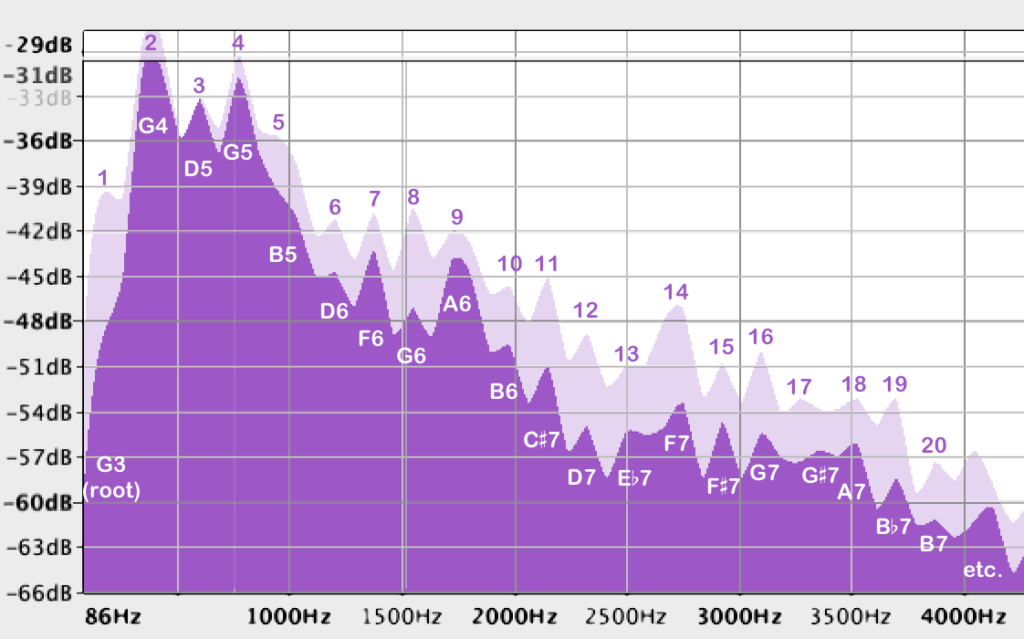(Tip no. 95 from 100 MORE Orchestration Tips, to be released March 2020)
Compared to a unmuted tone, a muted string tone suppresses the root and dampens the sheen of the tone; but still has a fairly strong body.
NOTE: 100 MORE Orchestration Tips features several chapters which diagram the differences between muted and unmuted instruments. This is the chapter that addresses muted strings – while other chapters diagram the differences in which occur when adding mutes to tuba and trumpet, and muting or stopping horn. For quick reference, I define the first partial of each spectrum as the “root;” the 2nd, 3rd, and 4th partials as the “body;” and partials from the 5th up to the 20th and higher as the “sheen.”
Before we examine the diagram, let’s review what a string mute does and how it works. Just as with brass mutes, the string mute’s function is not necessarily to quieten the dynamic force of the instrument. Mutes strings can still play fairly loud. Their purpose, rather, is to filter the tone, changing its character.
This is achieved by limiting the transmission of vibration from the string through the bridge and into the body of the instrument. A mute might be anything that can clamp on or even just cling in a rubbery way. Old-style mutes were essentially forked pegs that gripped in between each string; but due to the quick-change demands of contemporary composers, most modern mutes consist of some little clamp or rubber band that sits loosely on the strings between the bridge and tailpiece. This is quickly slid up into place by the player, sometimes within a fraction of a second (though do not take advantage of this speed with abandon – see 100 Orchestration Tips no. 77, a preview of which you can find here). The result is a bridge that suppresses some of the natural resonance of the violin, but leaves certain overtones nearly the same as before.
Now let’s look at a detail from the diagram on the next page. You’ll see right away that the root of a muted tone is quite soft. While it bulges slightly, in this case as an open violin G3, that bulge is radically limited compared to a normal tone, with about a -13dB difference. The result is that the bottom is somewhat knocked out of the tone, as much as if you were to fade that range back with a graphic EQ.

What intrigues me most is that the body of the muted tone, represented by partials 2 through 4, spikes almost as strongly as a normal tone. And in fact on the 3rd partial of my diagram, there’s no difference whatsoever – they both sit at -33dB. This means that the bridge is allowing these partials through almost completely with no dampening of tone. There’s also a quick falloff from the 5th partial, the most “nasal” of the overtones. So muted tones will be strong in body, but more from the chest than the face.

From here, we see that the higher partials, the “sheen” of the tone, are somewhat dampened. Not with the severity of the root throughout, but with an average difference of about -6dB. The roots, 3rds, and 5ths are all brought down in strength on partials 6, 8, 10, 12, 16, and 20. But it’s interesting to see which partials stick out a little bit, bringing a bit of character to the tone. Most prominent are the 7th and 9th, with only around a -2dB drop from an unmuted note. These are probably the most responsible for that whispery crispness of muted strings, that when combined with the strong body of tone can express undefinable loneliness and longing.

Adding all these strengths within the limitations together gives you the uniquely subtle timbre of muted strings. It’s not that they’ve been drained of some colour – but more that certain colours within the normal tone have been preserved while the others have been toned down. For an orchestrator focused on discreet, haunting textures, the following diagram might be well worth keeping in mind.

general suppression of the root and the sheen of the tone, but with a strong body, and more pronounced 7th and 9th partials.









